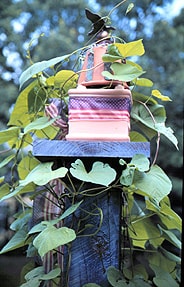 A well designed garden contains groups of compatible plants, yes, but it also includes structural elements that remain in the garden through all four seasons, and vertical elements that visually tie the garden to the sky. Structure, often called the bones of a garden, can come from manmade constructions such as stone walls, fences, and arbors, or from hedges and evergreen shrubs.
A well designed garden contains groups of compatible plants, yes, but it also includes structural elements that remain in the garden through all four seasons, and vertical elements that visually tie the garden to the sky. Structure, often called the bones of a garden, can come from manmade constructions such as stone walls, fences, and arbors, or from hedges and evergreen shrubs.
 The vertical features, which often are part of the garden’s bones, might be small trees, shrubs, or the aforementioned fences and arbors. But what if the garden is too small for a tree or an arbor?
The vertical features, which often are part of the garden’s bones, might be small trees, shrubs, or the aforementioned fences and arbors. But what if the garden is too small for a tree or an arbor?
In small spaces, a simple post can function as part of the garden’s structure, a vertical element, and a place for seasonal display. It provides a place to grow annual or perennial climbers, mount a sculpture, and decorate the garden for a holiday or special occasion. And best of all, the installation of a garden post is easily accomplished on a weekend.
Materials needed include a six by six or eight by eight post that is at least eight feet long, and two or three square pieces of lumber that are larger than post. Buy some decking screws that are long enough to go through the lumber squares, some outdoor caulking to fill any holes and smooth the seams, and some sandpaper…you are in business.
 Dig a hole about two feet deep, and place your post in the hole…use a level to make sure the post is straight, and fill in the soil around it, packing it down as you fill. (Check with the level as you fill sometimes the post will move as the dirt is placed around it.)
Dig a hole about two feet deep, and place your post in the hole…use a level to make sure the post is straight, and fill in the soil around it, packing it down as you fill. (Check with the level as you fill sometimes the post will move as the dirt is placed around it.)
 As you can see in the photograph, the square pieces of lumber are stacked on top of the post, and screwed down. Caulk the places where the boards meet, and fill any knot holes. If you want a smooth finish, sand with the sandpaper before painting. Finally, paint the post in a color that will harmonize with your house and garden.
As you can see in the photograph, the square pieces of lumber are stacked on top of the post, and screwed down. Caulk the places where the boards meet, and fill any knot holes. If you want a smooth finish, sand with the sandpaper before painting. Finally, paint the post in a color that will harmonize with your house and garden.
Your post can be used for a plant support as well as for the display of a garden ornament. Climbing roses, annual vines such as Thunbergia alata (black-eyed Susan vine) or sweet peas, or small perennial vines such as Clematis are all good choices for growing up your post. Be aware that the larger vines such as Wisteria or Honeysuckle would quickly overwhelm your construction.
Leave your post bare on top or add ornaments as you fancy; gazing balls, watering cans, sculptures and weathervanes all make excellent post-toppers. You can put up something permanent or change your ornament according to your whim or the season. Put up something unexpected once in awhile and keep the neighbors on their toes!
